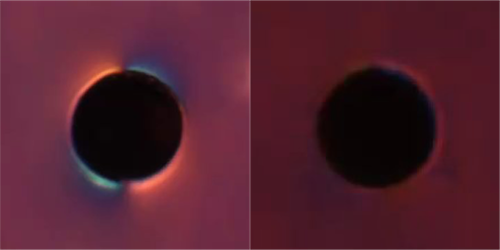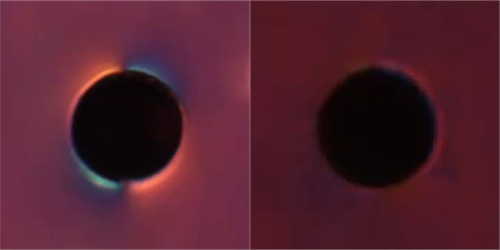Now You See Them, Now You Don’t
The molecules in liquid crystals can both flow like a fluid and align as in crystals. If a particle is placed into a liquid crystal, it introduces defects in the material’s structure. But now researchers from the University of Colorado, Boulder, have developed disk-shaped particles that can interact with the crystal without creating defects. This system could be used to answer fundamental questions about the conditions under which such defects form, which are relevant to many fields of physics.
Ivan Smalyukh and colleagues created disk-shaped particles from gold foils through a sequence of chemical etching and lithography. The thicknesses of the foils varied from a hundred nanometers up to a micrometer. They placed the particles into a liquid crystal and sandwiched the system between two glass slides, with the crystal’s molecules aligning parallel to the glass walls. The team studied the system using polarizing optical microscopy—at the position of a defect, the liquid crystal changes color as a result of disorder in its structure.
For disks thicker than a few hundred nanometers, two point defects appear at the disk’s “poles.” The liquid-crystal molecules “want” to align parallel to each other as well as to the disk’s curved surface, and when they can’t, disorder creeps in. But these defects don’t appear for 100-nm-thick disks. In that case, the molecules don’t “see” the disk, and they align as they would if no particle were present. The team could, however, introduce defects in the liquid crystal by morphing the thin disk particles into hollow pyramids—defects formed inside and outside the tips of the pyramids. To minimize the number of defects in the system, the pyramids self-assembled into rows or diamonds. This approach could be used to create patterned structures.
This research is published in Physical Review Letters.
–Katherine Wright
Katherine Wright is a Contributing Editor for Physics.





